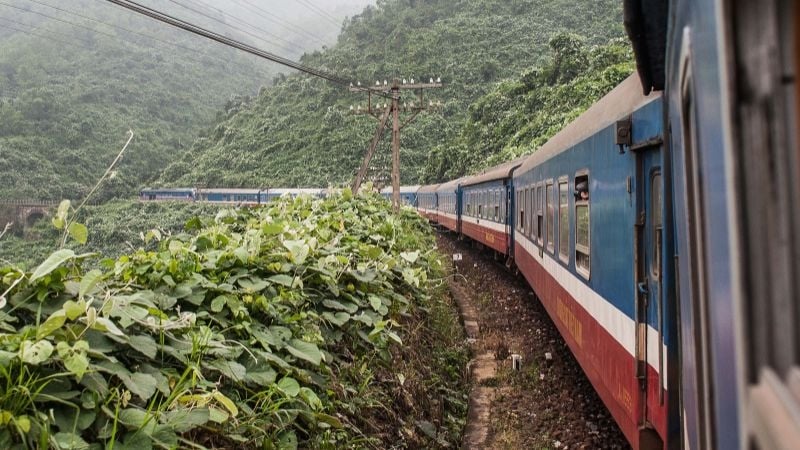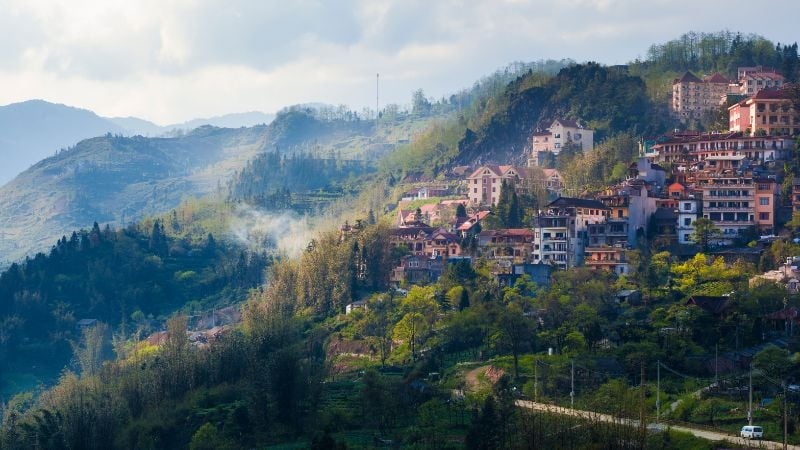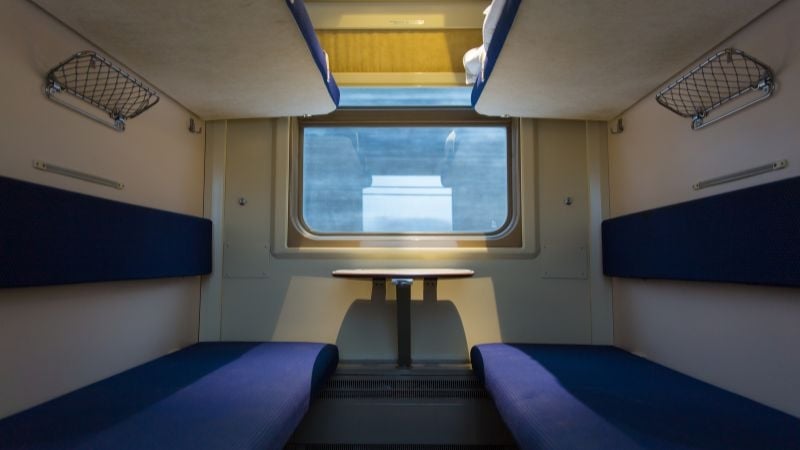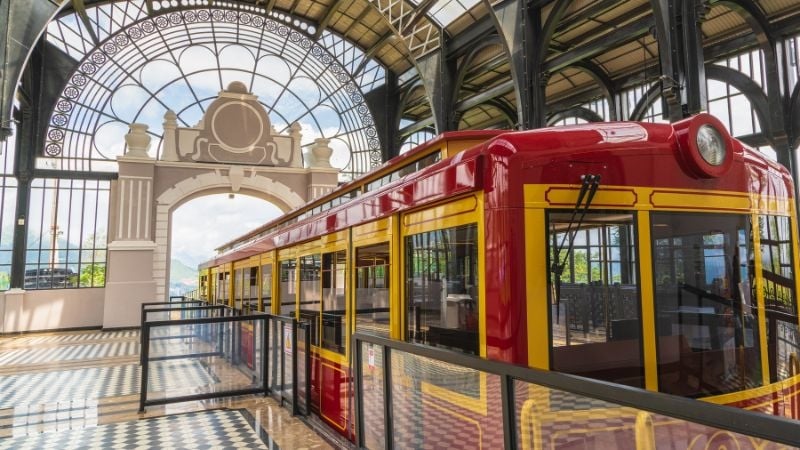With its dramatic coastlines, misty mountains and rural heartlands, Vietnam is made for slow travel, and there’s no better way to take it all in than by train.
While Vietnam’s rail network isn’t the fastest or flashiest, it offers a charming, scenic and surprisingly comfortable way to explore the country from north to south. Here’s everything you need to know about travelling in Vietnam by rail.
Also read: How to Travel Around South Korea by Intercity Bus: A First-Timer’s Guide
Why take the train in Vietnam?

Image credit: Kate OMalley via Canva Pro
Travelling by train in Vietnam is about the journey as much as the destination. It’s not the quickest option, but it is one of the most atmospheric and rewarding. The railway network is a legacy of French colonial rule, centred around the north–south Reunification Line linking Hanoi and Ho Chi Minh City.
While domestic flights and buses are often cheaper or faster, train travel offers something they don’t: room to stretch out at a slower pace, and a front-row seat to Vietnam’s natural beauty. It’s also a safer and more environmentally conscious option.
Main train routes in Vietnam

Image credit: Xaume Olleros via Canva Pro
Hanoi to Ho Chi Minh City (Reunification Express)
Covering more than 1,700 kilometres, this is Vietnam’s main railway artery. The full journey takes roughly 32 to 35 hours.
Most travellers break the long journey up with scenic or cultural stops in places like Hue, Da Nang, Nha Trang or Quy Nhon. Trains are fairly comfortable and run several times a day.
Views alternate throughout, but you’ll get more coastal scenery on the east-facing side, so the right-hand side when heading south, and left-hand side when heading north.
Hanoi to Lao Cai (for Sapa)

Image credit: thaidangphoto via Canva Pro
This popular overnight route takes you towards the northern highlands and is a favourite with trekkers heading to Sapa. The journey takes around 8 hours.
Note that the final stop is Lao Cai station, about an hour’s drive from Sapa town, so you’ll need to arrange a transfer by minibus or taxi upon arrival if you’re headed there! Views are generally better on the right-hand side when heading north, especially in the early morning as you approach the mountains.
If you’re considering an alternative to the train, sleeper buses run directly from Hanoi to Sapa town, saving you the need to transfer at Lao Cai. The journey takes around 6 to 7 hours, with a variety of companies operating both day and night departures.
These buses typically feature reclining beds, individual air vents, and sometimes Wi-Fi or USB charging. While the ride can be bumpy on winding mountain roads, it’s a popular and convenient option, especially if you prefer travelling straight to the hills.
Hanoi to Hai Phong
A short and efficient train ride (about 2.5 hours) that’s handy if you’re heading to Cat Ba Island or Ha Long Bay. It’s a good way to skip the traffic of northern Vietnam.
Sit on the right-hand side when heading east for more open countryside views, passing through villages, rice paddies and industrial zones on the way to the coast.
Da Nang to Hue

Image credit: HuyNguyenSG via Canva Pro
Often cited as the most scenic stretch in the country, this 2.5 to 3.5-hour ride winds past cliffs, beaches and forested hills.
Sit on the left-hand side when heading north, and the right-hand side when heading south for the best views. This stretch hugs the coast and offers spectacular views of cliffs, beaches and the sea.
Ho Chi Minh City to Phan Thiet / Nha Trang
Beach lovers can take a comfortable train from the southern capital to Phan Thiet (gateway to Mui Ne) or further up the coast to Nha Trang, one of Vietnam’s most popular seaside cities.
Also read: 3D2N Da Nang Itinerary For A Relaxing Weekend Escape From Singapore
Classes and what to expect onboard

Also read: GluckKMB via Canva Pro
Vietnamese trains are fairly basic but perfectly serviceable, especially if you book the right class. Here’s a guide to what’s typically available:
- Soft sleeper: Air-conditioned cabins with four bunks. This is the most comfortable option for overnight trips.
- Hard sleeper: Six-berth cabins with thinner mattresses and less privacy.
- Soft seat: Ideal for shorter daytime routes; seats are cushioned and often air-conditioned.
- Hard seat: Basic wooden seats; avoid unless on a very short or budget-conscious journey
Toilets and cleanliness standards vary across trains and sometimes even carriages, so it’s a good idea to bring tissues, hand sanitiser, and your own basic toiletries, just in case.
As for other handy tips, it’s a good idea to bring snacks and water, though some trains have trolleys selling food and drinks. Also, be prepared for delays, as Vietnamese trains are known for running late, so leave plenty of buffer time.
Booking your train tickets

Image credit: Karin Chantanaprayura via Canva Pro
You can book tickets:
- At the station (bring your passport)
- Online via Vietnam Railways
- Through third-party agents like Baolau or 12Go
Prices are fixed, and foreigners pay the same rates as locals. Book early if you’re travelling around public holidays, or if you want a soft sleeper on a popular route.
The most scenic train journeys in Vietnam
If you’re short on time and just want the highlights, don’t miss these:
- Da Nang to Hue: Arguably the most photogenic ride in Southeast Asia, beginning with a slow, winding climb over the Hai Van Pass, one of Vietnam’s most iconic natural landmarks. On one side, you’ll see jungle-covered mountains, and on the other, sheer drops to the turquoise sea.
- Ninh Binh to Thanh Hoa: Dramatic limestone scenery through Vietnam’s inland karst region.
- Nha Trang to Quy Nhon: Palm-lined beaches, salt flats and rural views. Opt for the right-hand side when heading north for glimpses of fishing villages, salt flats and ocean vistas.
Also read: The Most Scenic Destinations in the Philippines: Best Places to Visit in 2025
It’s time to plan your Vietnam train travel route
It may not be the fastest way to get around, but it’s certainly one of the most rewarding. You’ll be able to experience misty mornings over rice paddies, coastal stretches you’ll want to photograph every five minutes, and the gentle rhythm of the tracks rocking you to sleep.
From bustling stations to quiet countryside stops, Vietnam by train offers a slower, richer way to travel, full of charm, scenery and a healthy dose of adventure. So book that ticket, pick a good window seat, and let the journey unfold, one track at a time.




